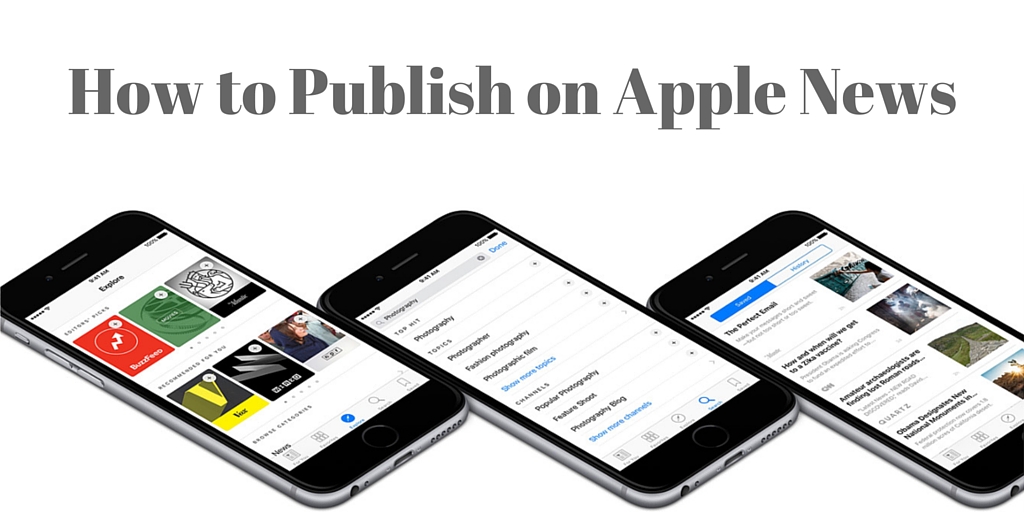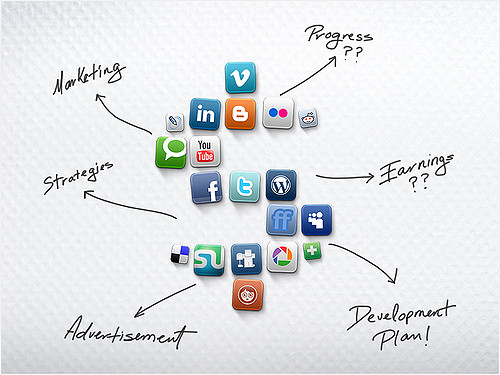
by Fronetics | Jul 25, 2016 | Blog, Content Marketing, Logistics, Marketing, Strategy, Supply Chain

Get your news in front of the one billion iOS users with this step-by-step guide to publishing on Apple News.
Do you use Apple News? If you have an iOS device (iPhone, iPad, or iPod Touch) and have upgraded to iOS 9 or beyond, the app is preinstalled.
Users love the easy-to-read interface and the fact that they don’t have to download a number of different third-party news apps. That’s because Apple News aggregates content from various media outlets, from the New York Times to local blogs, based on user preferences. You can refine what news you see by choosing your preferred publications and topics, which are as general as politics or as specific as the Chinese economy.
There are a number of topics and channels relevant to the supply chain. From supply chain management and automotive logistics to packaging news and sustainable brands, Apple News is an excellent source of content for companies in the industry.
Here’s more good news: Anyone can publish on Apple News. That means your business can distribute your content through this platform with the chance to reach the more-than-one-billion iOS users around the globe.
Signing up as a publisher is simple. Here are four easy steps to get started.
1) Sign into iCloud.
Go to https://www.icloud.com/#newspublisher and enter your iCloud login details. You can quickly create a free account if you don’t have one already. Click “Continue.” Note that you’ll need to agree to the End User License Agreement.
2) Set up your channel.
Complete details about your publisher name, contact info, and channel name. As a publisher, you can have multiple channels, each representing a different publication (such as a blog and a newsletter). After set up is complete, you can add a new channel by clicking “Create New Channel” and entering publisher and channel info.
Channel content is divided into sections. Your default section will contain the main content of your channel, but you can have up to 25 other sections to organize your content by topic or type. Apple suggests that 6 to 8 sections is optimal.
3) Upload your logo.
Upload a PNG file (smaller than 2 MB) of your logo that will be used throughout News to identify your content.
4) Select a publishing format.
You must choose between RSS feed or Apple News Format, which optimizes your content for iOS devices. Other benefits of Apple News Format include the ability to create articles in Publisher, add team members, get analytics, and earn revenue through iAd.
Once you submit all of this information, Apple will review your information and get back to you before your channel launches officially.
Learn more about publishing on Apple News.
Related posts:

by Fronetics | May 16, 2016 | Blog, Content Marketing, Logistics, Marketing, Supply Chain

Dear companies in the logistics and supply chain industries,
You have leveraged technology and innovation so that two-day shipping is becoming more of the norm rather than the exception. You have developed processes and standards for IT Asset Disposal (ITAD), which mitigate asset recovery management and increase data security. You have leveraged 3-D printing — disrupting the status quo.
Cathy Morris, senior vice president and chief strategy officer for Arrow Electronics, Inc., puts it well: “Products can be made, money can be invested, ideas can be brought to fruition, but without the supply chain everything stops. The supply chain provides routes to market; everything hinges on an effective supply chain.”
In short, logistics and supply chain — you are pretty damn awesome.
Given your awesomeness, I wonder why marketing firms have taken to courting your business by promoting that they do “content marketing for boring industries.” You are not boring (in the least). Why would you choose to partner with someone that finds you boring?
Content marketing can be an effective tool for your business. When aligned with your business objectives, content marketing can:
- Build brand awareness
- Position your company as a thought leader within the industry
- Increase engagement with customers, partners, and stakeholders
- Educate and inform customers, partners, and stakeholders
- Build trust
- Allow you to manage your reputation
- Generate leads
Given the impact a successful content marketing strategy can have on your business, doesn’t it just make sense to find a marketing firm that recognizes the value of your industry and of your company; a firm that recognizes your awesomeness?
I lead the digital and content marketing arm of Fronetics Strategic Advisors. Our firm focuses on companies within the logistics and supply chain industries. Why do we do this? We do this because we have deep expertise in these industries, and because we believe in these industries. We stay up to date on industry trends. Phrases like: “Can you believe the capabilities of company x’s new forklifts?” and “Wow, the reverse logistics implications of that are going to be significant,” are daily conversations for us.
I am not saying that you need to choose our firm as your marketing firm, but, please, choose a firm that believes in you. When choosing an outsource partner, evaluate not just the firm’s marketing capabilities, but also their knowledge of your industry.
You do incredible work. Find a partner who recognizes this, not one who finds you boring.

by Fronetics | Mar 9, 2016 | Blog, Content Marketing, Marketing

The other day a client called to express his frustration with content marketing. Not only was he disappointed with the number of leads that his company had obtained to date, he was also disappointed with the number of sales. He was ready to call it quits and pull the plug on all content marketing efforts.
This client was not the first to call and express frustration, nor will he be the last. Unfortunately, there is a misconception that as soon as a company incorporates a content marketing into their strategy, they will be flooded with leads — leads served on a silver platter and leads all boxed up and tied with a bow. I wish content marketing could do this — it can’t. That being said, walking away from content marketing is a big mistake — content marketing is an effective strategy that companies should employ.
The buying process for B2B buyers has become more complex and longer. The 2015 B2B Buyer’s Survey Report found that 53% of respondents reported their purchase cycle was longer than it was the previous year. The buying process has gotten longer because the majority of buyers (82%) are using more sources to research and evaluate products and services, and they are spending more time in the research phase itself. A full 80% of respondents reported they spend more time on research alone — this is up from 58% in the previous survey.
Social media and vendor-focused content are two key places where buyers turn to conduct research. More than half (53%) of survey respondents reported that social media plays in their research process, and 86% of respondents reported that content such as case studies and product data sheets influence purchase decisions.
The increased focus on research has changed when the buyers engage with a sales rep. Today, the average buyer progresses nearly 60% of the way through the purchase decision-making process before engaging with a sales rep.
Back to my client. I walked my client through these facts, and then we walked through the metrics we track on the monthly basis. Since my client had started using content marketing, traffic to his company’s website had increased significantly, visitors to the website were spending longer on it than they had before, and they were looking at more pages. Additionally the company’s social reach had grown and engagement — with customers, prospects, and others within the industry — had increased considerably. All of these things, I pointed out, were positive. I then reminded my client that the typical sales cycle for his company and industry was 12-18 months — far longer than the few short months that he had been using content marketing.
I spent the next few minutes going over the company’s content marketing strategy. We decided to make a few tweaks, and then discussed both goals and expectations going forward.
It is important for companies to recognize that content marketing should be a part of their strategy — more than ever, B2B buyers are looking for information and are using that information to make buying decisions. Companies need to be using social media. Companies need to be creating and curating quality content. It is equally important, however, for companies to realize that content marketing is not magic. Content marketing doesn’t shorten the buying process; rather it changes it. Moreover, content marketing doesn’t deliver sales — sales people still play a large role in lead nurturing and closing deals.
You may also like:
This was originally published on Electronics Purchasing Strategies.

by Fronetics | Mar 3, 2016 | Blog, Content Marketing, Marketing, Social Media, Strategy

Source: Rosaura Ochoa | Flickr
Here’s how marketers can launch a B2B social media program that grows business.
A recent Harvard Business Review article discloses that a number of B2B CEOs still believe social media isn’t right for them, that it’s a tool for the B2C segment. In reality, many B2B marketers successfully leverage social media to engage potential customers, gather market intelligence, build brand awareness and reputation, discover and intercept customer problems, and influence purchasing decisions before sales calls are ever made.
In short, if you are not in the B2B social media game, you are missing out on enormous business opportunities.
Getting started with social media can seem like an intimidating task, especially if your C-suite is skeptical of the benefits. Here are six steps to launching a B2B social media program that will grow your business to its full potential.
1) Speak in the right terms.
Convincing management that you want your team to spend more time on social media to gain “followers” or get “shares” might be a hard sell. To win support, focus your argument around the factors that are most important to them. Lead generation, lead nurturing, conversions, sales, ROI, profits: this should be the vocabulary with which you approach this conversation.
2) Create a strategy — and put someone in charge.
Only 11% of companies without a documented content marketing strategy find their efforts to be successful, compared to 60% of companies with a strategy in place. And that number rises to 86% when the company designates someone to lead the strategy. Working with an experienced marketing consulting firm, like Fronetics, you can develop an inbound marketing strategy that aligns with your business objectives. And whether someone on your team heads up execution or you outsource that responsibility, the leader should continually monitor analytics and tweak the strategy accordingly. Which brings us to…
3) Determine which analytics to track.
In the B2B world, it’s not about shares, likes, or impressions, though those numbers speak to your brand exposure. (Read more about so-called “vanity metrics” here.) Leads generated, conversion rates, sales, and ROI are going to be the things you’ll want to track. If you have a good, flexible strategy in place, these metrics will help you adjust your efforts to ensure you’re achieving your business objectives.
See: The Six Marketing Metrics Your Boss Actually Cares About.
4) Develop quality content.
Twenty-seven million pieces of content are shared every day — and a large portion of it is crap. A social media presence could be pretty pointless unless you’re using it to push content that is original, high quality, and representative of your brand. One of the biggest mistakes B2B companies make is using social channels to push a sales pitch. You’ll quickly lose your audience, who is turned off by a strong sales pitch. Social media is about engaging your audience, building brand awareness, and offering valuable information.
See: Three Elements of Good Content.
5) Decide which channels are right for your business.
Who are you trying to reach, and what are you trying to tell them? These are good questions to ask when trying to determine which platforms will comprise your social media program. There’s a wealth of information out there about which channels are used by whom and when. You’ll also want to choose channels that you’ll be able to maintain regularly and which play to your strengths. As an obvious example, if you don’t have the capability to make videos, YouTube probably isn’t for you. Remember, you’ll likely want to work through several different channels to reach a maximum number of potential customers.
See: Which Social Media Channels Should Your B2B Business Use?
6) Follow your competitors.
Following your competitors is a great way to stay up to date on what they’re doing, especially if you don’t have a ton of time or money for competitive research. And when I say “follow,” I don’t mean “copy or imitate.” I mean subscribe to their blogs, engage with them on social media, and like and share their content that you find meaningful for your audience. This way, you become part of the industry conversation happening online, and you know exactly what your potential customers are seeing from (and how they’re reacting to) your competitors.
See: The Role of Social Media in Supply Chain Intelligence.
Related articles:

by Fronetics | Jan 5, 2015 | Blog, Content Marketing, Internet of Things, Logistics, Marketing, Social Media, Strategy, Supply Chain, Talent

Here are the top supply chain and logistics blog posts of 2014
2014 is over and a new year has begun. We look back at the content we created and shared in 2014.
Looking at content focused on the supply chain and logistics industries, there are three topics which garnered the most interest:
- The use of social media and content marketing;
- Supply chain talent;
- Technology.
Here are the top ten supply chain and logistics blog posts of 2014 based on pageviews. #1 receiving the most pageviews.
The Internet of Things trend is quickly approaching and will impact the way we live and work through increased productivity and efficiency. Supply Chain Management will continue utilizing these advanced technologies to improve factory workflow, increase material tracking, and optimize distribution to maximize revenues. Read the full blog post.
Within the past five years companies within the logistics and supply chain industries have begun to see social media as a strategic tool and have begun to actively use and leverage social media. A survey conducted by Fronetics Strategic Advisors looks, broadly, at the use of social media within the logistics and supply chain industries. The report discusses use, motivations, preferences, benefits, and challenges. Read the full blog post.
Santa’s supply chain was the first to run “in the cloud.” Read the full blog post and check out the infographic.
Looking at the manufacturing, supply chain, logistics, transportation, distribution and freight industries there are a few companies that have emerged as leaders – companies that exemplify the business value of creating and executing digital, social media, and content marketing strategies. Cerasis, a freight logistics company, is one of these companies. Read the full blog post.
The supply chain industry has a talent crisis. The question is: how can we solve this crisis? To answer this question I turned to Rodney Apple, founder of the SCM Talent Group. Apple has worked as a supply chain recruiter for the majority of his 19+ year career within the staffing industry and he has filled more than 1,000 positions within the industry ranging from executive-level in Fortune 500 headquarters settings to leadership and staff-level roles across large networks of manufacturing and distribution facilities within North America. Apple’s role affords him the ability to witness the talent crisis from the perspective of the industry, the company, and the job seeker. Read the full blog post.
The purpose of this series of blog posts is to give others in our industry and especially those in the manufacturing industry, a guide to create an effective digital, social media, and content marketing strategy which will produce results for your company. If you have followed the Cerasis blog since its launch in March 2013, you have noticed that we work really hard at executing our strategy. The reason we work so hard is because we are passionate about educating the marketplace on information that matters to them. In that way, we want to be the de facto expert in the manufacturing and logistics industries. If we can help those who are our customers and potential customers (manufacturers and distributors) with best practices around logistics and freight, as well as manufacturing industry news, we are continuing our mission of driving long term value (even if we give the information away for free). The result (we hope and have seen) is that people view us as the expert and will want to engage us in a long term relationship as their logistics services provider. We hope this is helpful and you learn something from it! Read the full blog post.
3PL provider Coyote Logistics is one of the fastest growing companies in North America. The company’s incredible growth (five-year growth: 3,585 percent) and tenacious spirit has not gone unnoticed. Forbes included Coyote in its list of Most Promising American Companies; Supply & Demand Chain Executive listed Jeff Silver, Coyote CEO, as one of their “Pros to Know;” and the company was listed as one of the best places to work by the Chicago Tribune. There are undoubtedly many factors that have contributed to the success of the company. Coyote’s approach to social media is likely one of the company’s keys to success. Read the full blog post.
Here’s the thing – the supply chain industry is perceived by those outside the industry as having no “wow” factor whatsoever. If the supply chain industry is going to attract new and qualified talent, it needs a face lift. It is time for the supply chain industry to re-brand itself. Read the full blog post.
Without a comprehensive social media strategy, your message may be getting lost in the chatter. There are a number of tools that will help you monitor your online influence and, effectively, make the necessary adjustments to ensure your efforts are paying off. Here are 10 free tools to help you measure your social media ROI. The basic features of each of these tools are free. Read the full blog post.
Regularly tracking your relationship with your suppliers and their performance toward your expectations is critical to ensure the success of your business. One mechanism for tracking this is the supplier scorecard. A scorecard is in essence a report card for your supplier. Supplier scorecards when used effectively can help maintain a healthy supply chain and will benefit both parties. If not used effectively supplier scorecards can damage the supplier relationship and hurt both businesses. Read the full blog post.








